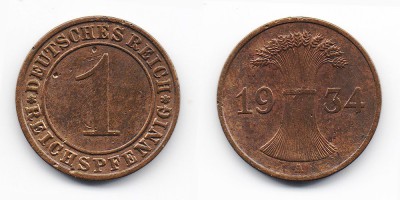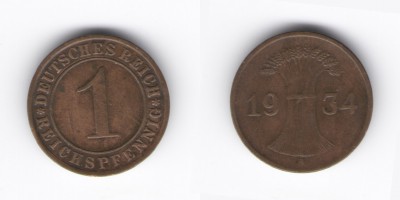The year 1934 was marked by many interesting events in the monetary system that took place both in Europe and around the world.
Chasing a fairly large batch of silver coins of the Third Reich. It is worth recalling that they approved these coins in 1933, but the year of their mass release can be called 1934. They are quite rare, because in the future all these coins were seized.
Also, 1934 was marked by the release of an anniversary coin model of 5 Reichsmarks. 900 silver samples were used for them. The issue of the coin was timed to the 175-year-old date from the date of the birth of the German Friedrich Schiller, who is known to the whole world as a philosopher and aesthetics, poet and playwright.
In the middle of the main side of the coin is the emblem in the form of an eagle with lowered wings. It is framed by oak leaves with acorns. Bottom is the semi-ring signature - 5 Reichsmarks, and on top - the German Empire. The reverse is decorated with a portrait of Friedrich Schiller, the date of the jubilee 1759 - 1934 is shown at the bottom and oak leaves are depicted, and at the top is a half ring inscription by Friedrich Schiller. The coins were produced in circulation of 100 thousand pieces and made in the city of Stuttgart.
Completion of the copper-nickel period in the USSR, which is interesting for coin collectors. It was during the period of the years 31-34 that the most valuable coins of this alloy were issued. Further, it also applies, but the cost of copies of the subsequent ready is much lower.
In 1934, 20 kopecks were issued, which were distinguished by the fact that on the right side of the ear closest to the globe, there were 2 axes. To meet such pennies today is considered a great success, since only one surviving specimen is known, which is in the collection of the State Hermitage Museum.
In 1934, the US law was also passed, which initiated the creation of a gold reserve. The minting of coins from the precious metal was discontinued, and all the collected coins and the incoming gold were melted into ingots, which were sent for storage.
These were the most useful facts for coin collectors. But the events do not end there:
1. In the same year, small copper coins with denominations of up to 5 kopecks and nickels up to 20 appeared in use in the Tuva People’s Republic. Coins were minted in Leningrad, since Tuva did not have its own mint.
2. For the island of Mauritius, the year 1934 was marked by the appearance of silver coins of a quarter, a half and a whole rupee.
3. In 1934, the coins of Turkey stopped placing Arabic script. It was replaced by the indication of the current date, written in Latin letters and corresponding to the Western calendar.
4. Also this year, the first Fiji coins were issued - pound. Prior to that, there used the money of England and Australia.
5. For Panama, this year was quite important, because the local coin, Balboa, received a solid ratio to the US dollar (1 to 1). Because of this, it has long been a local equivalent.
 Russian
Russian English
English Deutsch
Deutsch Spanish
Spanish Português
Português













